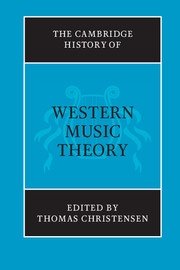Introduction
Published online by Cambridge University Press: 28 March 2008
Summary
Music theory, Carl Dahlhaus has warned us, is a subject that notoriously resists its own history. How, he challenges us, is it possible to write any meaningful history of a discipline whose subject matter has shifted so dramatically over time? Topics of musical pedagogy that we today take for granted as integral to music theory were not always so considered – rules for writing counterpoint or realizing a figured bass, for instance. Conversely, many of the traditional components that made up the quadrivial science of musica theorica are now considered peripheral subjects lying precariously close to occult and esoteric thought, or more benignly, perhaps, as part of some mathematical or acoustical subdiscipline. Nor are these contrasting allegiances mutually exclusive at any given historical period. Widely diverging conceptions of music theory can often be found jostling with one another in the same historical culture, within the oeuvre of the same writer, and occasionally even in the same publication.
As a pointed illustration of this diversity, we might consider three texts stemming from the same decade of the early seventeenth century: Thomas Campion’s A New Way of Making Fowre Parts in Counter-point by a Most Familiar, and Infallible Rule (London, c. 1618), René Descartes’s Musicae Compendium (c. 1618; printed Utrecht, 1650), and Robert Fludd’s Utriusque Cosmi, maioris scilicet et minoris metaphysica (Oppenheim, 1617–21). Each of these works has been classified as “music theoretical” (although ironically, none of them actually employs the title “music theory”). Yet it is certainly not the case that all three works represent similar kinds of theory.
- Type
- Chapter
- Information
- The Cambridge History of Western Music Theory , pp. 1 - 24Publisher: Cambridge University PressPrint publication year: 2002
References
- 4
- Cited by



